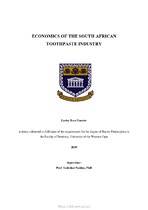| dc.description.abstract | Introduction: Untreated caries of the permanent dentition is the most prevalent condition
worldwide. Ongoing globalisation and the heightened exposure to a refined, westernised diet
against a backdrop of deficient health services and inadequate implementation of preventive public
health measures, means that dental caries remains pervasive, especially in emerging economies. In
South Africa, an estimated 90% of caries remains untreated, disproportionately affecting the poor
and detrimentally impacting on the economy. The use of an effective fluoridated toothpaste is
regarded as the best clinical practice available today in caries management. Aim: The aim of the
present study was to evaluate the availability, pricing and affordability of fluoridated toothpastes
marketed to South African households and to identify mechanisms to improve financial access
among low-income households. Methods: A cross-sectional survey of fluoridated toothpastes,
retail price and unit weight/volume was undertaken. Following calculation of a median reference
price for each paste, affordability relative to household income brackets was assessed using a
modification of the WHO/HAI’s essential medicines pricing protocol. Affordability was expressed
in terms of the number of days of disposable household income required to purchase the annual,
household therapeutic dosage of a fluoridated toothpaste. Results: Despite the wide availability
(n=142) of fluoridated toothpastes, of those assessed for affordability (n=130), none and 49% were
affordable to households located in the first and second lowest income brackets, collectively termed
low-income earners. Accessibility (±96%) increased sharply for low emerging middle income
households and upwards. In general, as household income declined, the proportion of daily,
disposable income required to purchase the annual, household therapeutic dosage increased.
Households located in the lowest income bracket spent 104.3% of daily income on the annual
dosage of the lowest priced toothpaste in contrast to 0.23% spent by the wealthiest households.
Horizontal disparity in terms of affordability between household income brackets differed
significantly (p<0.00001). Conclusion: Stark inequity in affordability of fluoridated toothpastes
exists between low income and affluent households with dire implications in terms of oral health
and economic hardship suffered by the poor. To redress this social injustice, a number of price
regulatory policies and funding mechanisms are suggested to stimulate dialogue and urge all
relevant entities (clinical, legal, industrial, and governmental) to take action urgently. | en_US |

